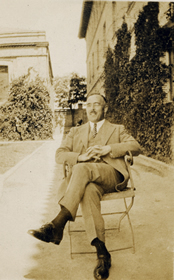 Tomás Navarro Tomás front of the Student Residence (Madrid)
|
In 1929, following a long period of preparation and thanks to a subsidy from the Junta de Relaciones Culturales, the work on the ALPI began. Most of the surveys were completed in a short time, between 1931 and the summer of 1936, at which point the civil war interrupted them and the project director had to leave in exile. In the late forties, as the political situation in Spain showed no signs of changing, Navarro Tomás decided to send the surveys notebooks which had been completed before the war to Madrid, to the Higher Council of Scientific Research (CSIC), the institution that had taken over the work of the Center for Historical Studies. During the last few months of 1950, Lorenzo Rodríguez-Castellano and Manuel Sanchis Guarner, two of the former ALPI fieldworkers, travelled to New York in order to take charge of the notebooks and to outline with Navarro Tomás the fundamental methodological bases that were to be followed, since the CSIC had agreed to hire them to organize the surveys that were still to be completed, and to prepare the atlas for publication. |
| Finally, after many ups and downs, in 1962 the CSIC published the first volume (Fonética) with 75 maps; but the publication then stopped and did not resume. With the project abandoned, the ALPI questionnaires remained scattered among the fieldworkers responsible for the three mains zones of the peninsula – Lorenzo Rodríguez-Castellano, Aníbal Otero and Manuel Sanchis Guarner, who until then had been in charge of preparing the materials. | |



